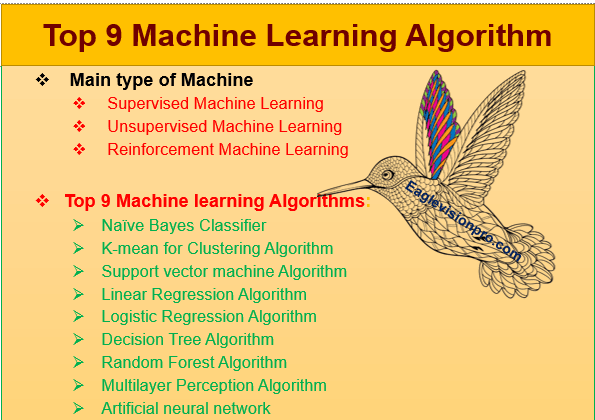Best Machine learning Algorithms in 2024

The bright future technology is machine learning, deep learning, and computer vision. According to a Harvard Business School survey, Data Scientist is the most in-demand and successful job in the 21st century. This article will give you a brief overview of the Best machine learning Algorithms every engineer should know.
Different types of machine learning algorithms were developed in this advanced era to solve real-world problems. These algorithms were developed by highly creative people. They are highly automated and can be improved with time.
Table of Contents
Main types of machine learning algorithms:
The Machine learning algorithms are divided into sub-three different classes.
Supervised Machine Learning Algorithms:
Although the teacher knows the right answers, the learning process continues until students know them too (poor children!). This is what Supervised Machine Learning Algorithms are all about. The algorithm is the student who learns from the training data and makes predictions which are then corrected by the teacher. The algorithm continues to learn until it achieves the desired level of performance.
Unsupervised Machine Learning Algorithms
This means that there is no teacher and students who are not wealthy can learn by themselves. Unsupervised Machine Learning Algorithms do not have a teacher and no specific answer. To learn more about the data, the algorithm is left to its own devices to discover the structure of the data.
Reinforcement Machine Learning Algorithms:
Here are some hypothetical students who learn from their mistakes over time (that’s just like life!). The Reinforcement Machine Learning Algorithms can learn the best actions by trial and error. This means that the algorithm learns new behaviors based on the current state of the algorithm and will determine the best future action.
Best machine learning Algorithms every engineer should know
At first, Machine learning algorithms are designed to solve complex data problems in real life. Now that you have an overview of the different types of machine-learning algorithms, let us look at the most popular ones that are used by data scientists.
Naive Bayes Classifier:
What would happen if you had the task of manually classifying data texts like a web page, document, or email? You would be mad! This task is accomplished by the Naive Bayes Algorithm. This algorithm is based upon the Bayes Theorem of Probability (you have probably seen it in maths), and it assigns an element value to a population-based on one of the available categories. Email Spam Filtering is an example of how the Naive Bayes Classifier Algorithm can be used. This algorithm is used by Gmail to classify emails as spam or not spam.
K-mean for Clustering Algorithm:
Firstly, Let’s say you want to search Wikipedia for the term “date”. Secondly, You can search for “date” on Wikipedia to refer to a fruit or a specific day. Or even a romantic evening spent with your loved one! Wikipedia then groups web pages discussing the same ideas by using the K Means Clustering Algorithm, which is a well-known algorithm for cluster analysis.
K is the K Number of Clusters used by the Clustering Algorithm to work with a given set of data. The output will contain K clusters, with the input data divided among them (as pages with different “dates” were partitioned).
Support Vector Machine Algorithm:
Firstly, for classification and regression problems, the Support Vector Machine Algorithm can be used. Secondly, this divides the data into various classes by finding a line (hyperplane), which allows for the separation of the data into multiple classes. The Support Vector Machine Algorithm attempts to find the hyperplane which maximizes the distance between classes (also known as margin maximization). This increases the likelihood of correctly classifying data.
The Support Vector Machine Algorithm can be used to compare the stock performance of stocks within the same sector. This allows financial institutions to manage investment decisions.

Linear Regression Algorithm:
Firstly, Linear regression algorithms signify the association b/w dependent and independent variables. Secondly, This algorithm shows the effect of changing the independent variable on the dependent variable. Thirdly, The independent variable is known as “the explanatory variable” and the dependent variable is referred to as “the factor of interest”.
One example of Linear Regression Algorithm used is in risk assessment within the insurance industry. Linear regression analysis can be used for determining the number of claims made by customers of different ages. Then, it can be used to deduce the riskier customer is as a result.
Logistic Regression Algorithm:
Logistic Regression Algorithm works with discrete values, whereas Linear Regression Algorithm uses continuous values to predict future events. It can be used for binary classification. If an event happens, it will be classified as 1. The given predictor variables are used to predict the likelihood of an event occurring.
Logistic Regression Algorithm is used in politics to predict whether a candidate will win or lose an election.
Decision Trees Algorithm:
Let’s say you are looking for a venue to host your birthday party. There are many things that will influence your decision, such as: “Is it Italian?”,” “Does it have live music?”, and “Is it close to your home?” Each question has a YES/NO answer that will help you decide. This is the essence of the Decision Trees Algorithm. This tree branching method shows all possible outcomes for a decision. The tests on different attributes are called internal nodes. The branches and leaf nodes represent the results of these tests.
The banking industry uses Decision Trees Algorithm to classify loan applicants based on their likelihood of defaulting loan payments.
Random Forests Algorithm:
The Random Forests Algorithm addresses some of the limitations in Decision Trees Algorithm. This is because the accuracy of the outcome decreases as the number of decisions in a tree grows.
In the Random Forests Algorithm, there are many decision trees that represent different statistical probabilities. These trees are all mapped to one tree, the CART model. (Classification as well as regression trees). The final prediction for Random Forests Algorithm can be made by polling all decision trees. The Random Forests Algorithm is used in the automotive industry to predict the future failure of any part.
K-Nearest Neighbour Algorithm:
Firstly, It splits data points into classes based upon a similar measure, such as distance function. Secondly, a prediction for a new point is made by looking through the entire data set as well as finding the K most closely related instances (the neighbors). Thirdly, the output variable for these K instances is then summarized. This might be the average of the outcomes for regression problems. For classification problems, it might be the most frequent class.
K-Nearest Neighbour Algorithm may require large amounts of memory or storage space to store all data. However, it only calculates (or learns) when a prediction will be needed.
Artificial Neural Networks Algorithm:
Firstly, Neurons are the foundation of our sharp wit as well as retentive powers in the human brain. Secondly, Artificial Neural Networks attempt to duplicate the neurons of the human brain by connecting nodes to each other. These neurons receive information from another neuron as well as perform different actions, then transmit the information to another neuron.
Human facial recognition is an example of Artificial Neural Networks. Images with human faces can be distinguished from images that are not facial. This could take several hours depending on how many images are in the database, but the human brain can identify as well as distinguish them instantly. See also 5 technologies that are changing social media




how many drops of cbd oil be used as a dose for pain relief